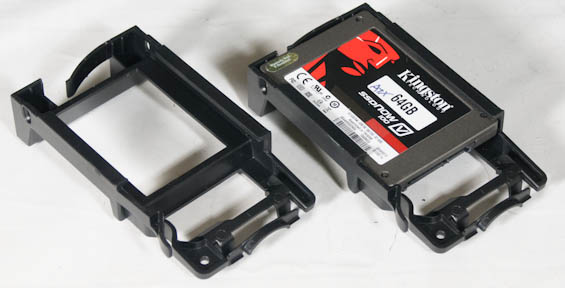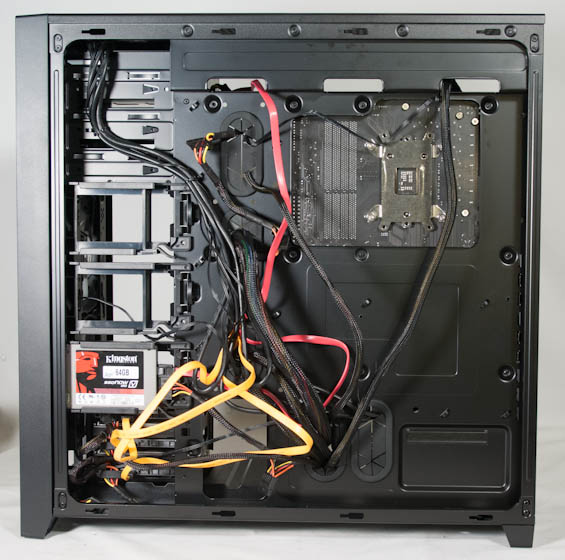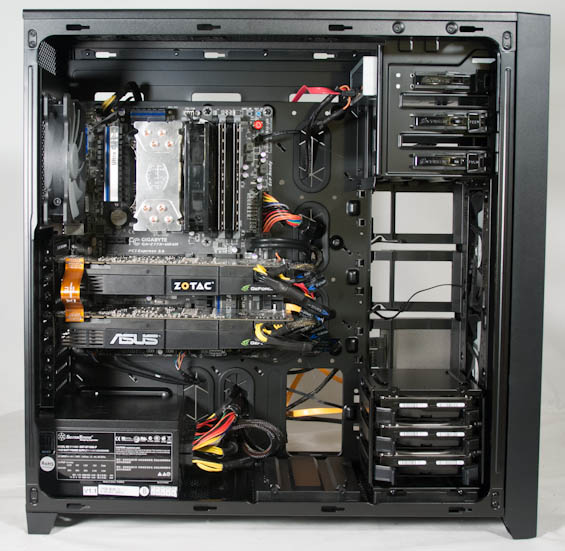Corsair Obsidian 750D Case Review
by Dustin Sklavos on September 24, 2013 6:00 AM EST- Posted in
- Cases/Cooling/PSUs
- Corsair
- ATX
- Case
If it weren't for the weight, assembling a system in the Corsair Obsidian 750D would almost be like a vacation. Corsair's trademark at this point is ease of use, and that continues with the 750D.
The side panels are both hinged and held in place with two thumbscrews. From there, installing the I/O shield and motherboard is easy; Corsair has extruded all of the motherboard mounting points from the tray itself, and added a guide peg in the center. There's also plenty of space surrounding the motherboard, making it easy to route cabling.
With all of the different drive form factors having toolless installation, you can imagine how easy that was to handle as well. The 3.5" drive trays are typical of Corsair, but they snap in nicely and securely (as opposed to the NZXT trays which have a hard time staying in place). NZXT handily beats Corsair's toolless retention mechanism for the 5.25" drive bays, though; Corsair's isn't bad, but NZXT's is incredibly secure. You'll probably want to screw in the drive on the opposite side just to be safe.

Corsair has been pursuing toolless mounting solutions for 2.5" drives pretty aggressively; they use modular, interlocking drive caddies for the Carbide Air 540, and those work well. With the 750D they have an even more novel approach, with a series of caddies that bridge the motherboard tray and front of the case. This system is also a pretty effective one, but if you're using a 7mm drive it's going to be a little loose. I'm not sure what they can really do about this. Create tiny drive cages and tiny drive trays that snap in on the sides? The arrangement of the 2.5" caddies behind the motherboard tray in the 750D is slick, but their alignment complicates cabling somewhat.

The power supply and expansion cards went in easily and smoothly, and cabling for the most part was a non-issue. Corsair's creative 2.5" drive solution does cause some minor problems, though. You can see where the bottom drive caddie would be that the cables from the 3.5" drives bunch up, and that's ignoring how the front fan cables have to route through one of the other caddies. The fan cables aren't a major issue, but the leads for the 3.5" drives are a problem waiting to happen. Kudos to Corsair for coming up with an innovative arrangement for the 2.5" drives, hopefully they can work out some of the kinks in a future revision.

For how hideous my cabling job is, Corsair designs continue to lend themselves well to very clean interior builds. As a teenager I was huge on the idea of having a windowed case, then through most of my twenties I was interested in having a more modest machine. As I've gotten older (and broken thirty) and case designs have gotten more elegant, I've started to see the appeal in having a slightly more showy build. The 750D's window is welcome; it's able to handle our full fat testbed with aplomb, and makes even my crappy wiring look decent.


_thumb.jpg)
_thumb.jpg)
_thumb.jpg)
_thumb.jpg)
_thumb.jpg)
_thumb.jpg)








40 Comments
View All Comments
alincioaba - Tuesday, September 24, 2013 - link
The 3.5" cages are stackable that's good... my question is can you add an extra one (provided that corsair will sell you one)?garadante - Tuesday, September 24, 2013 - link
Sure looks like it, as that's what they offered with the 900D. Perhaps the drive cages are even identical? I know the 900D came with 2 or 3 drive caves but you could have 5 installed total I think.Grok42 - Tuesday, September 24, 2013 - link
Not my choice of case for other reasons but I have to give them a lot of credit for being able to stack cages and selling additional ones. Now if they would only sell 2.5" in addition to 3.5" cages.BillyTheBigBone - Friday, February 14, 2014 - link
yes you can. I ordered one from them.Alan G - Tuesday, September 24, 2013 - link
In this day and age, two USB 2.0 along with two USB 3.0 ports on the front panel? Why?DanNeely - Tuesday, September 24, 2013 - link
At $159 "it's cheaper" isn't a good excuse; but I'm sure that's still part of it. Probably Corsair's explanation if asked would be that a lot of mid range mobos still only have a single USB3 header and very few people would be plugging in 3 USB3 devices at once anyway.IMO the better option would be to include either a short adapter cable to connect a USB3 cable to a USB2 header, or to wire the second connector onto the cable itself like the dual connector cable you often see on front panel audio. I'd prefer the first option because it lets people with 2 USB3 headers toss the adapter in their junkbox and have a cleaner build.
Liquid_Static - Tuesday, September 24, 2013 - link
What else is going to go there...LB-ID - Tuesday, September 24, 2013 - link
I was doing a fresh Win7 install on a new computer the other day, couldn't figure out why the keyboard and mouse kept going dead during the install process. Figured out it was lack of USB3 support on the OS, so was very very happy to have a couple of USB2 ports on my Nanoxia DS1. Sometimes it pays to have backwards compatibility available...Threnx - Tuesday, September 24, 2013 - link
I would like it a lot more without the gaudy window. It's 2013, who still thinks those look good? They should go the way of lighted LED fans.flemeister - Tuesday, September 24, 2013 - link
Not you, evidently! =DI love the look of a clean side panel window, free of any ugly fan grills. And anyway, it's 2013, where an all-black interior is now pretty much standard for ATX cases. More and more PSU's come with decent looking cables, whether just black insulation on the wiring, or braided sleeving installed by default. And it's *very* easy to find nice looking motherboards and video cards now, compared to ~2009 and earlier. There's been no better (or easier) time to show off the guts of your rig! =)